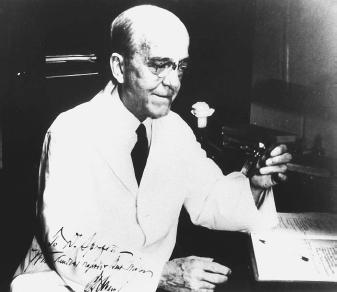Oswald Avery
CANADIAN-AMERICAN PHYSICIAN
1877–1955
By the early 1940s, scientists knew that chromosomes existed and that they were composed of smaller units called genes. Chemical analysis had revealed that the eucaryotic chromosome consists of about 50 percent protein and 50 percent deoxyribonucleic acid (DNA). There was no particular interest in DNA for several previous decades because no role had been assigned to it. This changed when a Canadian-born American named Oswald Avery showed that DNA is responsible for the transmission of heritable characteristics.
Avery moved from Canada to New York City in 1887. He attended Colgate University and in 1904 received his medical degree from the College of Physicians and Surgeons at Columbia University. He practiced medicine

for several months before he became more interested in the transmission of infectious diseases. In 1913, Avery arrived at Rockefeller Institute, where he worked as a bacteriologist for over 43 years.
Avery and his co-workers studied the life cycle and chemical make-up of Diplococcus pneumoniae , or pneumococci, a species of bacteria that causes pneumonia. Avery's interest was sparked by British microbiologist Frederick Griffith's work with pneumococci. In 1928, Griffith described an experiment in which he injected mice with a mixture of a harmless strain of living pneumococci and the dead remains of a virulent strain of the bacteria. The mice died from infection by the live organisms of the virulent strain, though the organisms had been dead when they were administered. By 1932 Avery focused on transformation—a process by which heritable characteristics of one species are incorporated into another different species.
In an attempt to duplicate Griffith's work, Avery and his colleagues began to grow large quantities of virulent type III capsulated pneumococcus. They purified the live virulent encapsulated bacteria and then killed them by extreme heat. The bacteria's polysaccharide protein, which makes up the capsule or outer envelope, was then removed. The remaining portion of the dead bacteria, its polysaccharide gone but capsules intact, was added to living, unencapsulated bacteria. It was found that the offspring of these living bacteria had capsules. Avery had determined that the active transforming principle, as Griffith had described earlier, still remained. Because the polysaccharide protein had been removed for the test, it could not be the transforming factor.
Avery wanted to be certain that the active agent was the DNA and not a small amount of protein contamination. To verify the result, a quantity of DNase, an enzyme that would destroy the DNA without affecting the protein, was prepared and added to the sample. When a portion of bacteria was tested, it could no longer transform the unencapsulated bacteria into encapsulated bacteria. Avery and his co-workers had conclusively proven that DNA was the transforming principle responsible for the development of polysaccharide capsules in the unencapsulated bacteria.
This experiment, first published in 1944, was extremely important because, for the first time, scientists had proven that DNA controls the development of a cellular feature. It also implicated DNA as the basic genetic material of cells and stimulated James Watson and Francis Crick to later discover its structure and method of replication. Today we understand that DNA is the fundamental molecule involved in heredity.
SEE ALSO Watson, James Dewey .
Bibliography
McCarty, Maclyn (1985). The Transforming Principle. New York: W. W. Norton.
Severs, Vesta-Nadine, and Whiting, Jim (2002). Oswald Avery and the Story of DNA. Bear, DE: Mitchell Lane.
Internet Resources
Dolan DNA Learning Center. Cold Spring Harbor Laboratory. "Oswald Theodore Avery (1877–1955)." 2003. Available from http://www.dnaftb.org/dnaftb/concept_17/con17bio.html
National Library of Medicine. Profiles in Science. 2003. "The Oswald T. Avery Collection." Available from http://profiles.nlm.nih.gov/CC/Views/Exhibit/narrative/after.html
Rockefeller University. 1994. "Rockefeller University Celebrates 50th Anniversary of Discovery That Genes Are Made of DNA." Available from http://www.rockefeller.edu/pubinfo/avery.nr.html
Wolfram Research. 2003. "Avery, Ostwald Theodore (1877–1955)." Available from http://scienceworld.wolfram.com/biography/Avery.html
Comment about this article, ask questions, or add new information about this topic: